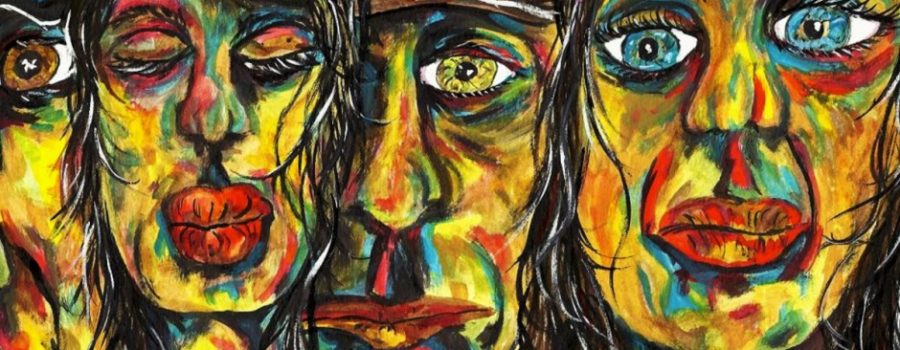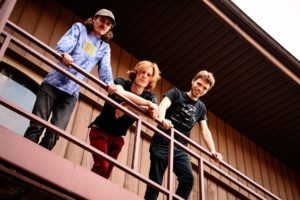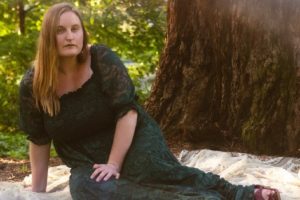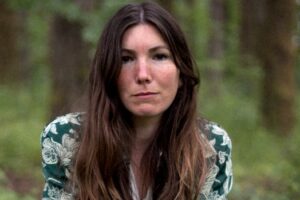“The secular communion of everyday people.”
Art above and throughout this feature © Duane Kirby Jensen
— All rights reserved. Please do not copy. —
“Contemplation” from Mystica Organicum — Charles Reix
DUANE KIRBY JENSEN
PAINTER — POET
— ABSOLUTELY HYPO PRODUCTIVE ART MONSTER —
photos by peggy anne Larson (or as designated)
THE CONVERSATION: A three panel overview.
Panel One: Eight Conversations About the Essence of Womanhood And The Peaceful Absence of Men. 7 1/2′ x 62″ Acrylic on Linen — Panel two: Two Conversations About Love and Five Contemplations About Loss. 7 1/2” x 62” — Panel Three: When Windows Eavesdrop on the Conversations of Women, Buildings May Blush, Shimmy with Laughter, or Shed a Tear. 7 1/2” x 62” Acrylic on canvas
Artists Statement
ZO has followed the art of Duane Kirby Jensen for many years — and we view much of it as a kind of emotional dialogue with life. From his poetic titles, to the often unplanned works that emerge naturally and freely into a series of diptychs, triptychs and various multi-tiered works, Duane “contemplates” — and then works through that contemplation — to make art.
This quote given by Duane in an interview with Didi Menendez sums up a bit of his process.
“I want to capture an individual’s moment the way a filmmaker would. I think of my paintings as cinematic stills. With each brush stroke, I am creating one frame of a biographical film. Within my mind I create a whole back-story about my subject that gives richness to their life that I try to evoke in each painting. I want people to view the subjects, as if they were eavesdropping on a moment of inner dialogue. My primary tool is body language. I love the angles of people’s bodies, the sharp lines of noses, necks, jaw line and the flow of hair as it cascades. It reveals everything about a character. As I paint, I think in terms of film. The core of the image I am painting is what the camera lens sees. I then tilt the lens to whatever angle will enhance the particular mood I am trying to capture.” 2008 Duane Kirby Jensen
We so enjoy Duane’s work because a part ZO’s purpose is to share ideas as well as learn from others that are exploring the “power of being creative.” Ultimately, we believe that all of our journeys are circular and that the knowledge we are gaining through life, art and each other will usher us into a different kind of universe where we will finally understand our experiences — from a perspective outside of them — much like an artist viewing a subject.
ZO ARTS CONSORTIUM
SPONSORS, CONTRIBUTORS, and ARTISTS
in all Creative Disciplines.
thoughts from Duane

The Fragility of Identity — “… do you go mad or do you reach deep.”
Above: He Sobs Within the Memories of Her, Whose Grave is Covered by Snow, But Whose Laughter Still Rings in His Heart. — © 2008 By Duane Kirby Jensen, 15 x 20, Ink & Charcoal on Paper
…..I have always been drawn to the question of “Identity.” Be it in art, books, or the cinema. It is easy for people to define themselves in good times. What interests me is what happens if one’s life is turned inside out and upside down, be it the loss of a job, a loved one, war, becoming shipwrecked, witnessing an atrocity or surviving one and so forth. These are events that can make individuals question who they are, and can play havoc on our sense of identity. Once that identity unravels – is there anything or anyone left? Can we reclaim ourselves? Or do we enter the void. These are the questions I love exploring. These are the core questions that exist in each of my series, with the exception of the Kohaku series.
…..The means by which I explore the Fragility of Identity is by capturing the interior dialog an individual is having with themselves when they feel no one is watching. It is at this unguarded moment, when thoughts and emotions seep into view. These are the emotions that lead to the most interesting narrative lines and what drives my work. A number of people have commented over the years that I have the “… ability to paint what is within a person’s heart.” I interpret this as my ability to paint the truth imbedded within my subject.
…..I have been asked, what outside sources have influenced my work in this direction. I will mention cinema as an influence first, because I feel it has had the greatest influence on my visual style. I think back to Alfred Hitchcock’s, Lifeboat (1944), Andrzej Wajda’s Kanal (1957), Kaneto Shindô’s Onibaba (1964) and Sydney Pollack’s They Shoot Horses, Don’t They? (1969). These films are visually stunning, but more importantly, they are the study of individuals pushed to and past the frayed edges of their identity. These four films illustrate beautifully how cinema has affected my emotional sensibility.
…..In these movies each character eventually reaches their breaking point. The question then arises do they go mad or do they reach deep, finding a resolution and overcoming what could have been the loss of their identity. This theme has been a staple of poets and novelists as diverse as Joseph Conrad’s Heart of Darkness to Haruki Murakami’s The Wind-Up Bird Chronicle.
…..One of the visual artists that I am drawn towards, when it comes to exploring identity is, Francisco de Goya (1746–1828). His subjects confront the brutality of war and starvation. The second is Francis Bacon (1909–1992), whose subjects melt into madness. The third is Théodore Géricault (1791–1824) who is famous for his painting, “The Raft of the Medusa”, which speaks to the breaking point men can travel to survive, yet never escape the shadow cast by their actions. I love to explore their works, close my eyes and visualize their paintings.
…..I think if you look at any of my subjects who have reached their breaking point, you will see the fire of defiance burning within, as they make one final move towards reclamation. It is this resilience that I want to capture.

She Tries to Imagine What a White Christmas Would Look Like as She Gazes into the Early Light that Awakens the Quiet Land She Calls Home. — © 2007 By Duane Kirby Jensen, 15 x 20, Ink on Paper

A Moment of Meditation Before the Disintegration of Identity Brings forth a Planet’s Rebirth
Above: Kohaku #11 — © 2013 By Duane Kirby Jensen, 7 x 10” / 178 x 254 mm, Ink and graphite on paper
…..The Kohaku series is unlike any of my other work. It is more meditative and does not project questions. It is void of a preset identity. I began the first sketch as I sat with my friend Jack McCarthy, who was nearing death. During that time Carol, Jack’s wife, and I discussed Buddhism and the simplicity inherent in both Japanese and Chinese art.
…..Jack would pass in and out of sleep. When he awakened he would asked to see what I had been sketching, then for me to explain the concept behind it. He found the falling fir boughs peaceful.
…..I have always had an affinity for the Japanese the use of red/white within their architectural design. When these two colors are used together they are referred to as Kohaku (Ko = Red and Haku = White). It seemed an appropriate time to create paintings that were truly as gentle as the man who I sat with. It is important to note, I did not want to be an American painter exploring Asian themes. I used the Kohaku combination as a way to explore themes that interested me in a unique and creative way.
…..By incorporating the red square, often found within Japanese architecture (set back from the primary picture window), I was able to create meditative works. Within these paintings, the red square pulls the viewer’s eye deep into the painting.
The Disintegration of Identity
…..I never envisioned becoming a painter who created meditative works. It has been a long road from the complexity of the work most people know and expect from me to the minimalism of the Kohaku series. Looking back on the Kohaku Series, I realize it was a necessary time of refection, allowing me to marshal my energy for works of even greater complexity than I had previously engaged in.
…..The ‘Disintegration of Identity’ series was the antithesis of my Mannequin series. In that series, Mannequins gained consciousness and through consciousness they became sentient beings. The series showed the mannequins forming a community and questing for knowledge which eventually lead them into the desert.
…..With ‘Disintegration of Identity’ I illustrated what outcome might look like when an individual or society as a whole loses its core identity. Bodies began to dissolve, peel, fold, or shatter until nothing remained. Within this, nature began to return, first by the use of fir boughs falling, then nests and hives inhabiting and regaining a foothold within a humanity caving in on itself.

Disintegration of identity #40 —
© 2013 By Duane Kirby Jensen, 7 x 10” / 178 x 254 mm, Ink and graphite on paper

Forgotten gods. Forgotten Lands. The Ultimate Exploration of the Fragility of identity.
Above: The First Poppy Blooms After Countless Seasons of Darkness. — © 2014 By Duane Kirby Jensen, 6 x 8 x 2 inches (15.2cm x 20 cm)ink and acrylic on claybord
…..Totems for Lesser Gods has, over time developed into the Forgotten God series. This series began when I started looking at objects and placed them in the theoretical hands of people who had never been exposed to science or manufacturing. Would these people view these everyday objects as gifts from the gods? If so, could these objects become totems and items of worship.
…..Expanding on this thought, the more people who have become educated and who have embraced the role of science as a means of explaining the unknown has inversely decreased the number of people reliant on belief in an everyday god or gods. Do these gods then disappear, as if they never existed, do they slip into a black dimension of the forgotten? Once cast adrift, do these gods struggle to regain their reliance? This creates a fantastic philosophical debate and a wide tapestry for artistic exploration.
…..As science and the industrial revolution freed people from ‘old thinking’ and their reliance on old gods to define the universe around them, humanity itself began to do greater lasting harm to the planet. It is this harm – taken to artistic extreme, that I have explored off and on since 2006. The momentum built through these paintings, and to an extent the majority of my series of work has led me to The Forgotten Land series which currently dominates my thinking.
…..The Forgotten Land series focuses on flowers blooming where buildings and man-made structures once stood, or whose remnants stand as a harbinger of what was. Some might view this series in a negative light, due to the lack of human habitation. I see it as a positive, that the planet has found a way to bounce back from human abuse and bloom again.
…..Within this series you can also note that the palette I am using features more blues and grays. At its core, I am using the same colors as previous paintings, but in this case, these colors have been muted by gray undertones and the predominance of blue.
…..A Facebook friend, Jude Adebosoye Ogunade asked me, “The canyon and the flowers…are they on a single theme… or is that a continued composition?”
…..I responded, “Thanks for the question Jude – It is a single theme. The world has tilted – be it over population, genocide, climate change, disease – to the point where humans have almost disappeared from the planet. The flowers signify the planet slowly healing itself.”
…..The ability to heal is a powerful statement. With many of my climate change paintings, I view them as extreme warnings. It is my hope that we humans can heal ourselves and our planet without the threat of extreme depopulation or extinction.

Two Offerings to Forgotten Gods — © 2013 By Duane Kirby Jensen, 10 in x 15 in (25.4 cm x 38.1 cm)

New Beginnings at the End. — © 2014 By Duane Kirby Jensen, 10 x 20 x 2 inches (25.4cm x 50.8 cm)ink and acrylic on claybord

Points on a Continuum or How the Laughing Man Witnessed Pathways Through the Underlying Fabric of the Universe. © 2012 By Duane Kirby Jensen, 46 x 60 Acrylic on Canvas
“Traditionally, as a painter, you seldom get to see or hear people’s reaction to your work. The wonderful thing about sharing my paintings on Facebook (and MySpace before that), is that people can share their reactions with me. For some, my work opens the door to memories that they had not visited in years. For others, it is it is a spontaneous sharing. For me this interaction is priceless.” – Duane Kirby Jensen








































